
Description and causes of keratoconjunctivitis. Main symptoms and diagnosis. Methods of treatment, prevention.
The content of the article:- What is keratoconjunctivitis
- Reasons for development
- Main symptoms
- Treatment methods
- Medicines
- Folk remedies
- Prevention measures
Keratoconjunctivitis is an ophthalmological pathology of allergic origin, in which the conjunctiva and cornea become inflamed. The disease occurs when exposed to bacterial and viral infections, allergens, and while taking medications. Tends to go away after stopping contact with irritating substances.
What is keratoconjunctivitis?
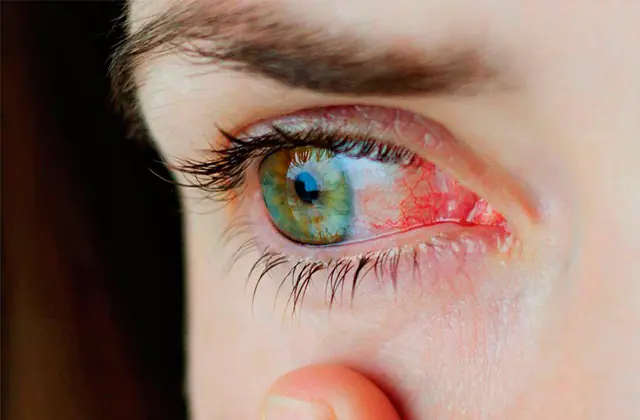
Pictured is keratoconjunctivitis
Keratoconjunctivitis is an allergic disease that affects the eye membranes. Occurs when exposed to pathogenic microorganisms, chemicals and other irritating factors. It is observed mainly in young and middle-aged patients, both male and female. Rarely develops in children over 2.5 years of age.
The first signs of the disorder may first appear during pregnancy. In this case, therapy is difficult, since most drugs are undesirable for use during pregnancy.
The inflammatory process is classified as follows:
- acute - develops sharply, tends to self-eliminate;
- chronic - characterized by a long, sluggish course, also prone to self-limitation after eliminating irritating factors.
The allergic form of the disease occurs through direct contact with triggers: dust, pollen, animal hair, household chemicals, cosmetics.
With the bacterial form of the disease, symptoms begin to decrease after 72 hours, provided that treatment was started in a timely manner. The patient recovers completely after 2 weeks.
During therapy, it is not recommended to use exclusively folk recipes, as this can provoke the transition of the acute form of the disease to chronic.
Reasons for the development of keratoconjunctivitis
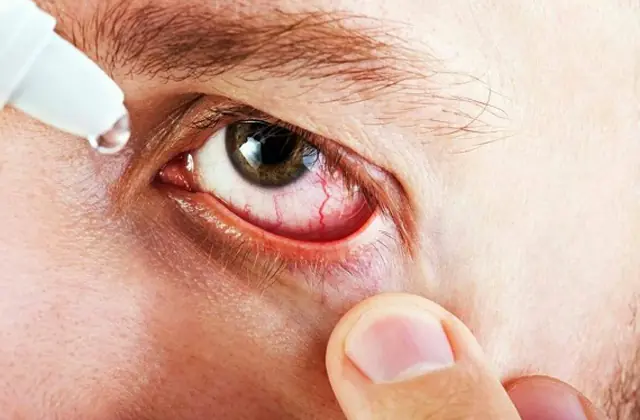
Keratoconjunctivitis of the eye develops in patients whose intrathoracic lymph nodes and endocrine glands are affected by the tuberculosis bacillus. The disease progresses if a person has suffered an acute allergic reaction to toxic substances.
Predisposing factors that can provoke kertoconjunctivitis include:
- helminthic infestation;
- individual food intolerance, especially dairy products, sugar, refined foods, gluten;
- lice infestation;
- failure to comply with personal hygiene rules;
- dysfunction of the immune system.
If a person tends to use other people's cosmetics or personal care products, the likelihood of contracting keratoconjunctivitis increases. The disease develops rapidly, immediately after the patient interacts with pathogenic microorganisms, allergens and other irritating factors.
Main symptoms of keratoconjunctivitis
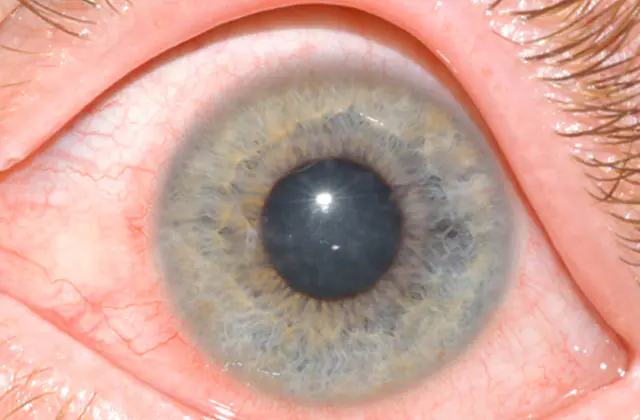
The disease first affects one eye and then spreads to the other. The affected organs of vision turn red and swell. The patient complains of pain, burning and itching, visual acuity decreases, purulent, mucous discharge, and eyelid spasms are observed. The clinical picture worsens if the patient continues to interact with household dust, animal hair, plant pollen, household chemicals or cosmetics.
The most characteristic symptom of keratoconjunctivitis is intense itching, which leads to redness of the eyes, injury to the cornea, and secondary bacterial infection. The eyes become dry and red.
Important! With keratoconjunctivitis, not only local changes are observed, but also general health worsens.With keratoconjunctivitis of the eye, lacrimation increases, the patient does not tolerate bright lighting. In severe cases of the pathological process, body temperature rises, lymph nodes enlarge, a feeling of weakness, runny nose, headache, and sore throat occurs. The face turns red, the skin peels.
To confirm the diagnosis, a survey and physical examination of the patient are carried out, lymph nodes are palpated, and eye biomicroscopy is performed using a slit lamp. To confirm tuberculosis, a Diaskintest or Pirquet test is prescribed. Depending on the results obtained, the doctor decides how to treat the disease.
To find out the exact causes of keratoconjunctivitis, additionally consult with a phthisiatrician, allergist, or immunologist.
Methods for treating keratoconjunctivitis
The treatment regimen for keratoconjunctivitis is selected individually for each patient, depending on the cause that provoked the pathological process. They prescribe medications and follow a diet: limit the consumption of simple carbohydrates, sugar, refined foods, gluten, and dairy products. Patients are recommended to take long walks in the fresh air and use sunglasses.
Medicines for keratoconjunctivitis
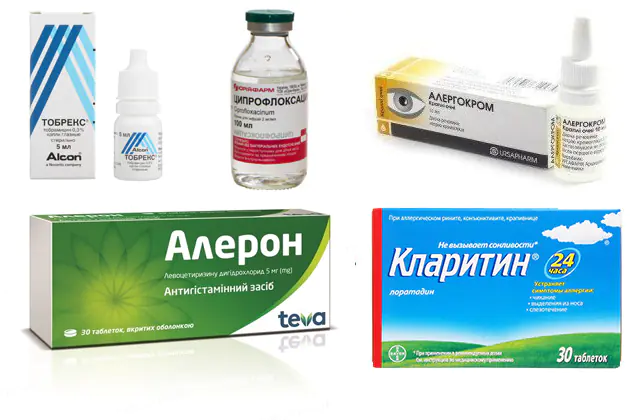
Treatment of keratoconjunctivitis requires an integrated approach using medications for local application, as well as systemic effects on the disease. The dosage, frequency and duration of drug use are determined individually for each patient.
To eliminate an allergic reaction with keratoconjunctivitis, the use of systemic antihistamines is recommended:
- Aleron. A new generation antiallergic medicine based on levocyteresine. Available in the form of tablets for internal use. The drug is indicated for acute and chronic allergic diseases, including keratoconjunctivitis. Quickly reduces itching, redness, swelling. It is recommended to take the drug 1 tablet at night. The maximum daily dose for adults with severe allergy symptoms is 2 tablets. If the recommended dose is not observed, drowsiness increases, and negative reactions from the gastrointestinal tract and central nervous system are possible. The price of the drug is 120 rubles. (45 UAH). Analogs: Alerzin, Allergokol, Allerginol Plus, Zodak, Cetrilev.
- Claritin. A drug based on loratadine in the form of tablets and syrup for internal use. The drug is used once a day until you feel better. The use of tablets or syrup may cause drowsiness, headache, and increased heart rate. The cost is 210 rubles. (80 UAH). Analogs: Loratadine, Lorano, Erolin, Clarisens, Claridol, Loratavel.
For local treatment of keratoconjunctivitis, the following drugs are used:
- Allergokrom. A drug with antiallergic effect in the form of eye drops. Prevents the release of inflammatory mediators, reduces the severity of allergies. The product is used for acute and chronic allergic keratoconjunctivitis. Allergokrom is recommended to instill 1 drop up to 4 times a day. Therapy is continued as long as the patient is in contact with allergens. It is recommended to avoid using contact lenses during treatment. The price of the drug is 245 rubles. (95 UAH). Analogues: Ifiral, Kromohexal, Kromofarm, Lecrolin.
- Ciprofloxacin solution. An antibacterial drug from the group of fluoroquinolones, which prevents the growth and reproduction of pathogenic microorganisms. Available in the form of eye drops. Indicated for corneal ulcers, as well as for superficial eye infections. The medicine is instilled 1-2 drops into each conjunctival sac, up to 4 times a day. The duration of therapy is 1-2 weeks. The medicine is not prescribed to patients with intolerance to ciprofloxacin, pregnant women, and young children. The drug must be used within 30 days after opening the bottle of drops. Cost - 80 rubles. (30 UAH). The medicine does not have exact structural analogues in the form of eye drops.
- Tobrex. Eye drops based on tobramycin, a broad-spectrum antibiotic. They act on the DNA of pathogenic microorganisms and are effective against staphylococcal and streptococcal infections, Pseudomonas aeruginosa, and Klebsiella. This is a medicine for the treatment and prevention of bacterial infections. The introduction of 1-2 drops into each conjunctival sac is indicated. In acute cases of keratoconjunctivitis, the procedure is repeated every half hour to hour. Price - 300 rub. (115 UAH). Analogs: Medetrom, Okubrax, Dex-Tobrin.
- Oftalmoferon. Eye drops with antiviral, immunomodulatory, anti-inflammatory, antimicrobial, regenerating, local anesthetic properties. They have an antiallergic effect, prevent swelling, itching, and hyperemia. Used in the treatment of herpetic and adenoviral keratoconjunctivitis. Not prescribed to pregnant women or patients with intolerance to active substances. In acute cases of the disease, it is recommended to administer 1-2 drops into each conjunctival sac up to 7 times a day. After reducing the inflammatory process, the frequency of use of drops is up to 3 times a day. The price is 640 rubles. (250 UAH). The drug has no exact structural analogues.
- Oftagel. A drug for the complex treatment of keratoconjunctivitis sicca, which is accompanied by dry eyes. Replaces tear fluid, increases its viscosity and forms a protective moisturizing film on the surface of the eyes. During the application of the gel, the eyelid is pulled back slightly, the required amount of medication is applied, and then the eye is slowly closed. The duration of the course of therapy is determined by the doctor. While using Oftagel, the patient is not recommended to wear contact lenses. During therapy, short-term blurred vision, tingling, and irritation in the eyes may occur. The price of the drug is 260 rubles. (100 UAH). Analogues: Sikapos, Vidisik.
- Artificial tears. A tear fluid substitute based on water-soluble polymer substances that moisturize the cornea of the eyes. The active components create a protective layer on the surface of the cornea, keeping tears in the eyes for a long time. The drug is indicated in the complex therapy of keratoconjunctivitis sicca, which is accompanied by dry eye syndrome. Reduces burning and irritation, relieves discomfort. For keratoconjunctivitis, it is recommended to administer 1-2 drops. in each eye. Cost - 280 rubles. (110 UAH). The drug has no exact structural analogues.
To provide a general strengthening effect, vitamin preparations are used:
- Vigantol. A drug based on vitamin D, which is a prohormone that regulates most biochemical reactions in the human body. It has a beneficial effect on the immune system and accelerates the healing process from bacterial and viral infections. Suitable for patients of all age groups. The maintenance dosage for adults is 2000-4000 IU, for children - 1000 IU, unless the doctor recommends a different dose. In case of severe, laboratory-confirmed deficiency, a therapeutic dosage is prescribed. Cost - 180 rubles. (70 UAH). Analogs: Actival, Vitamin D3, Detramax.
- Neovitam. A complex of B vitamins that optimizes the functioning of the peripheral and central nervous systems, as well as protein, fat and carbohydrate metabolism. Accelerates the healing process and has a beneficial effect on the functioning of the visual organs. The price is 240 rubles. (94 UAH). Analogs: Neurobex, Neuromax, Vitaxon, Neurorubin.
To restore visual acuity in case of keratoconjunctivitis, use vitamin complexes for the eyes, such as Ocuvit Lutein Forte. This is a complex preparation based on lutein, fish oil, vitamin E, ascorbic acid, zeaxanthin, selenium, zinc. The active substances exhibit protective and antioxidant properties, prevent vision loss, and provide additional supply of vital nutrients. Recommendations for use: 1-2 tablets with meals, course of treatment - at least 3 months. The cost of the drug is 730 rubles. (280 UAH) for 30 tablets. The drug has no exact structural analogues. As an alternative, you can use other complexes to restore vision: Blueberry Forte in the form of tablets for internal use, Optix, Visio Balance.
Important! If calcium supplements are recommended, they are used with extreme caution, only after confirmation of a deficiency of this microelement.If the drug therapy regimen for keratoconjunctivitis does not have the expected therapeutic effect and the clinical picture worsens, it is recommended to discontinue treatment and seek repeated consultation with a doctor.
Folk remedies for keratoconjunctivitis
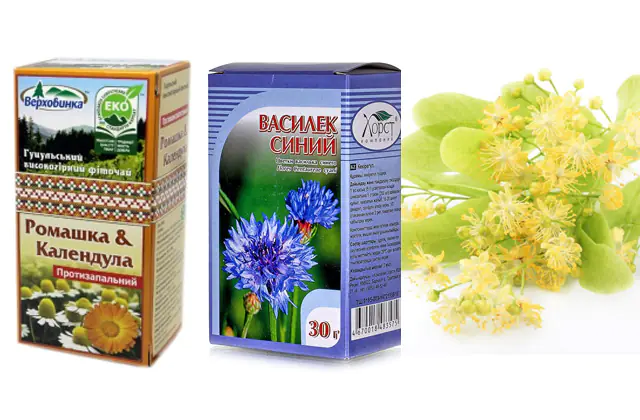
Folk remedies for the treatment of keratoconjunctivitis are used as an addition to the basic drug therapy regimen. They are not recommended for use for self-medication. Before starting therapy, you should consult with an ophthalmologist or allergist.
Traditional medicine offers the following recipes against keratoconjunctivitis:
- To reduce the inflammatory reaction, it is recommended to brew strong black tea, cool and use the tea leaves to apply compresses. The remaining liquid can be used to wash your eyes in the morning and evening.
- Chamomile and calendula are mixed in equal proportions, poured with boiling water and left for 40-60 minutes. Strain, moisten cotton pads generously with the resulting infusion and apply to the eyelids for 10-15 minutes. The procedure can be repeated several times a day. This remedy normalizes the outflow of pus and has a pronounced anti-inflammatory effect.
- To provide an antiseptic effect, use dill, fennel fruits, and bay leaves. The substances can be mixed or used separately to prepare a decoction or infusion. Using the resulting liquid, wash the eyes or make compresses.
- Pour 2 tablespoons of cornflower flowers into 600 ml of boiling water, boil for 2-3 minutes, remove from heat, cool. Moisten cotton swabs with the resulting liquid and apply to the eyes every 1.5-2 hours. The course of treatment is 20 days, then you need to take a break.
- Herbalists also recommend the use of healthy herbal teas based on linden, eyebright, blueberry, and sage. When body temperature rises, yarrow herb is added to the herbal mixture.
- For the bacterial form of the disease, it is recommended to mix eyebright, calendula, clover and blue cornflower in equal parts, brew with boiling water and leave for 40-60 minutes. Add a few drops of real, high-quality rosemary or lavender essential oil to the resulting liquid. Moisten cotton pads with the resulting liquid and wipe your eyes 3-6 times a day. Can also be used for compresses.
If during therapy the patient notices a deterioration in health and the clinical picture worsens, it is necessary to stop using folk remedies and re-consult with a doctor.
Measures to prevent keratoconjunctivitis

In order not to aggravate the course of the pathological process, at the first signs of the disease it is necessary to refrain from self-medication and seek advice from a doctor.
To prevent keratoconjunctivitis, it is recommended:
- limit contact with allergens;
- observe the rules of personal hygiene;
- eliminate helminth infections strictly under the supervision of the attending physician;
- promptly and efficiently treat bacterial and viral infections;
- refrain from using other people's cosmetics and personal hygiene products (napkins, towels);
- direct efforts to strengthen the immune system: hardening, reviewing the diet, moderate physical activity, observing a work and rest schedule, going to bed no later than 23:00;
- Do not use contact lenses and medications after their expiration date.
How to treat keratoconjunctivitis - watch the video:



